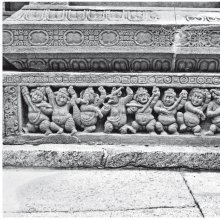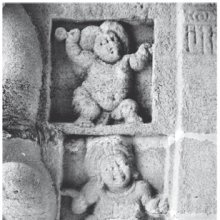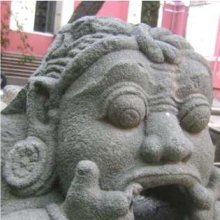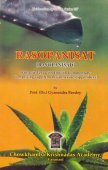Gana, Gaṇa, Gāna: 43 definitions
Introduction:
Gana means something in Buddhism, Pali, Hinduism, Sanskrit, Jainism, Prakrit, the history of ancient India, Marathi, Hindi, biology. If you want to know the exact meaning, history, etymology or English translation of this term then check out the descriptions on this page. Add your comment or reference to a book if you want to contribute to this summary article.
Alternative spellings of this word include Gaan.
Images (photo gallery)
(+51 more images available)
In Hinduism
Ayurveda (science of life)
Source: Wisdom Library: Āyurveda and botanyGaṇa (गण, “group”):—Suśruta, in his Suśrutasaṃhitā sūtrasthāna XXXVIII, classifies medicinal plants under thirty-seven groups, called Gaṇas. It is a Sanskrit technical term used in Ayurvedic literature.
The thirty-seven groups are:
- Vidārigandhādi,
- Āragvadhādi,
- Varuṇādi,
- Vīratarvādi,
- Sālasārādi,
- Rodhrādi,
- Arkādi,
- Surasādi,
- Muṣkakādi,
- Pippalyādi,
- Elādi,
- Vacādi,
- Haridrādi,
- Śyāmādi,
- Bṛhatyādi,
- Kākolyādi,
- Ūṣakādi,
- Sārivādi,
- Añjanādi,
- Parūṣakādi,
- Priyaṅgvādi,
- Ambaṣṭhādi,
- Nyagrodhādi,
- Guḍūcyādi,
- Utpalādi,
- Mustadi,
- Triphalā,
- Trikaṭu,
- Āmalakyādi,
- Trapvādi,
- Lākṣādi,
- Laghupañcamūla,
- Bṛhatpañcamūla,
- Daśamūla,
- Vallīpañcamūla,
- Kaṇṭakapañcamūla,
- Tṛṇapañcamūla,
They are classified according to its various characteristics. Most of the groups end with the prefix ādi, translating to “first” and usually refers to the first plant from the group.
Source: archive.org: Vagbhata’s Ashtanga Hridaya Samhita (first 5 chapters)Gaṇa (गण) refers to “story-tellers”, and is mentioned in verse 2.40-44 of the Aṣṭāṅgahṛdayasaṃhitā (Sūtrasthāna) by Vāgbhaṭa.—Gaṇa (Tibetan: thsogs), lit. “troop”, is interpreted by the commentators to denote “kathakacāraṇādayaḥ”—“story-tellers, minstrels, etc.”.

Āyurveda (आयुर्वेद, ayurveda) is a branch of Indian science dealing with medicine, herbalism, taxology, anatomy, surgery, alchemy and related topics. Traditional practice of Āyurveda in ancient India dates back to at least the first millenium BC. Literature is commonly written in Sanskrit using various poetic metres.
Purana and Itihasa (epic history)
Source: archive.org: Puranic EncyclopediaGaṇā (गणा).—A female attendant of Skanda. (Śalya Parva, Chapter 46, Verse 3).
Source: archive.org: Shiva Purana - English Translation1) Gaṇa (गण) refers to a group of deities.—Gaṇas are troops who generally appear in classes. Nine such classes are mentioned in the Purāṇas: They are (1) Ādityas (2) Viśvas or Viśvedevas (3) Vasus (4) Tuṣitas (5) Ābhāsvaras (6) Anilas (7) Mahārājikas (8) Sādhyas (9) Rudras. These are attached to Lord Śiva and serve under the command of Gaṇeśa, dwelling on Gaṇaparvata identified with Kailāsa—a peak of the Himālaya mountain.
2) Gāna (गान) refers to “songs”, according to the Śivapurāṇa 2.3.7.—Accordingly, after the Goddess (Umā/Śivā) incarnated as Pārvatī by becoming the daughter of Menā:—“[...] The lord of mountains rejoiced on seeing the child shining in dark splendour like that of the blue lotus. All the citizens there, both men and women, rejoiced much. There were great festivities. Different sorts of musical instruments were played. Auspicious songs [i.e., maṅgala-gāna] were sung. The dancing girls exhibited their saltatorial skill. The lord of mountains performed post-natal sacred rites and made charitable gifts to the Brahmins. [...]”.
Source: Cologne Digital Sanskrit Dictionaries: The Purana Index1a) Gaṇa (गण).—Of bhūtas; followers of Śiva, of gods, of Pramathas; attacked Kṛṣṇa at Śoṇitapura;1 eleven celestial gaṇas reckoned.2 Twelve groups of seven living with the sun in different parts of the year; their functions.3 Three clans of sages with twenty branches each. In the first epoch of Sāvarṇī; all of them sons of Mārīca Kaśyapa, with Bali as their Indra.4
- 1) Bhāgavata-purāṇa II. 6. 13: X. [65 (V) 46], [49]: [66. (V) 49]: 63. 6 and 10: XII. 10. 14.
- 2) Matsya-purāṇa 6. 44-5: 52. 21.
- 3) Vāyu-purāṇa 52. 24-35.
- 4) Ib. 100. 13f.
1b) Five groups of; Yavanas, Pāradas, Kāmbojas, Pahlavas and Śakas; defeated by Sagara, these appealed to Vaisiṣṭha who persuaded the king from further slaughter. Sagara changed their dharma and physical features; were degraded Kṣatriyas and debarred from learning Vedas.*
- * Brahmāṇḍa-purāṇa III. 63. 127.
Gaṇa (गण) is a name mentioned in the Mahābhārata (cf. ) and represents one of the many proper names used for people and places. Note: The Mahābhārata (mentioning Gaṇa) is a Sanskrit epic poem consisting of 100,000 ślokas (metrical verses) and is over 2000 years old.
Gaṇā also refers to the name of a Lady mentioned in the Mahābhārata (cf. IX.45.26).

The Purana (पुराण, purāṇas) refers to Sanskrit literature preserving ancient India’s vast cultural history, including historical legends, religious ceremonies, various arts and sciences. The eighteen mahapuranas total over 400,000 shlokas (metrical couplets) and date to at least several centuries BCE.
Kavya (poetry)
Source: Wisdom Library: KathāsaritsāgaraGaṇa (गण) is a Sanskrit name referring to a group of deities, attending Maheśvara at his dwelling place, which is the mountain-peak Kailāsa (located within Himavat), according to the Kathāsaritsāgara, chapter 1. Accordingly, “There (Kailāsa) dwells Maheśvara the beloved of Pārvatī, the chief of things animate and inanimate, attended upon by Gaṇas, Vidyādharas and Siddhas.”
The Kathāsaritsāgara (‘ocean of streams of story’), mentioning Gaṇa, is a famous Sanskrit epic story revolving around prince Naravāhanadatta and his quest to become the emperor of the vidyādharas (celestial beings). The work is said to have been an adaptation of Guṇāḍhya’s Bṛhatkathā consisting of 100,000 verses, which in turn is part of a larger work containing 700,000 verses.
Source: Brill: Śaivism and the Tantric Traditions (kavya)Gaṇa (गण) refers to “flocks (of crows)”, according to Bāṇa’s Kādambarī (p. 225-226).—Accordingly, while describing the shire of the Goddess Caṇḍikā, “[Then follows the image of the Goddess Caṇḍikā, which matches the conception of Kālarātri in the passage from the Mahābhārata:] [...] she bore the coquettish apparel of a woman going out to meet Mahākāla at night, with a vine-like body furnished with a raiment reddened with saffron-dye, with a face with red eyes, whose brows were furrowed into a frown, whose lip was crimsoned with betel that was blood, whose cheeks were reddened by the light shed from ear-ornaments of pomegranate flowers, with a forehead on which there was a tilaka dot of vermillion made by a Śabara beauty, covered by a magnificent gold turban. She was worshipped (ārādhyamāna) by goats... mice... antelope and black serpents... She was praised on all sides by flocks of old crows (kaṭhora-vāyasa-gaṇa); [...]”.

Kavya (काव्य, kavya) refers to Sanskrit poetry, a popular ancient Indian tradition of literature. There have been many Sanskrit poets over the ages, hailing from ancient India and beyond. This topic includes mahakavya, or ‘epic poetry’ and natya, or ‘dramatic poetry’.
Natyashastra (theatrics and dramaturgy)
Source: Wisdom Library: Nāṭya-śāstraGāna (गान) is a Sanskrit technical term referring to “song”, according to the Nāṭyaśāstra chapter 28.
Source: Google Books: Saṅgītaśiromaṇi: A Medieval Handbook of Indian MusicGāna (गान, “popular music”).—That which has been written by the composers (vāggeyakāra), which has special musical characteristics (lakṣaṇa) and is based on regional melodic forms (deśīrāga), etc., all this is popular music (gāna), which pleases the people. Traditionally, the two kinds of popular music (gāna) are:
- improvised (anibaddha, lit. “not composed”),
- composed (nibaddha).
Improvised music is musical variation (ālapti, from ālap, “to expatiate”). Composed music is formed with phrasal elements (aṅga) such as words, etc., that are present in the main sections (dhātu), viz.: regular words (pada), words of praise (viruda), musical metre (tāla), tone syllables (svara), drum syllables (pāṭa) and invocatory syllables (tenaka). (cf. Saṅgītaśiromaṇi 13.1)
Source: Shodhganga: Mankhaka a sanskrit literary genius (natya)Gaṇa (गण, “triad”).—A verse in Sanskrit is of four feet or quarters or pādas. Each pāda is regulated either by a number of syllables (akṣaras) or by a number of syllabic instant or measures (mātrās). Three successive syllables form a gaṇa (triad).

Natyashastra (नाट्यशास्त्र, nāṭyaśāstra) refers to both the ancient Indian tradition (shastra) of performing arts, (natya—theatrics, drama, dance, music), as well as the name of a Sanskrit work dealing with these subjects. It also teaches the rules for composing Dramatic plays (nataka), construction and performance of Theater, and Poetic works (kavya).
Vastushastra (architecture)
Source: McGill: The architectural theory of the MānasāraGaṇa (गण, “cluster”).—Besides āyādiṣaḍvarga, three other astrological principles are also mentioned in passing in the text (Mānasāra chapter 9), without always giving their full list or the formula to ascertain them: rāśī, “zodiacal sign”, gaṇa, literally, “cluster”, and nayana, literally, “eye”.
The astrological signification of gaṇa is that of a series of lunar mansions classed under the three heads of deva, god, asura, demon, and manuṣa, man. The text simply states that asura, demonic, and manuṣa, human, are to be avoided.

Vastushastra (वास्तुशास्त्र, vāstuśāstra) refers to the ancient Indian science (shastra) of architecture (vastu), dealing with topics such architecture, sculpture, town-building, fort building and various other constructions. Vastu also deals with the philosophy of the architectural relation with the cosmic universe.
Vyakarana (Sanskrit grammar)
Source: Wikisource: A dictionary of Sanskrit grammarGaṇa (गण).—A class of words, as found in the sūtras of Pāṇini by the mention of the first word followed by the word इति (iti); e.g. स्वरादि, सर्वादि, ऊर्यादि, भ्वादि, अदादि, गर्गादि (svarādi, sarvādi, ūryādi, bhvādi, adādi, gargādi) etc. The ten gaṇas or classes of roots given by Pāṇini in his dhātupātha are given the name Daśagaṇī by later grammarians.

Vyakarana (व्याकरण, vyākaraṇa) refers to Sanskrit grammar and represents one of the six additional sciences (vedanga) to be studied along with the Vedas. Vyakarana concerns itself with the rules of Sanskrit grammar and linguistic analysis in order to establish the correct context of words and sentences.
Chandas (prosody, study of Sanskrit metres)
Source: Shodhganga: a concise history of Sanskrit Chanda literatureGaṇa (गण).—All the metres (chandas) are calculated through specific gaṇas. While the Varṇa type metres have eight gaṇas in general consisting of three letters each; the Mātrā type of metres have five gaṇas. The gaṇas of Varṇa metre are ma-ra-ya-sa-ta-ja-bha-na. (Chandomañjarī 1.7)

Chandas (छन्दस्) refers to Sanskrit prosody and represents one of the six Vedangas (auxiliary disciplines belonging to the study of the Vedas). The science of prosody (chandas-shastra) focusses on the study of the poetic meters such as the commonly known twenty-six metres mentioned by Pingalas.
Shilpashastra (iconography)
Source: Shodhganga: The saurapurana - a critical study (shilpa)Gaṇa (गण) refers to the “associates of Śiva” and their form is described in the Saurapurāṇa as follows:—The svarūpa of the Gaṇas of Śiva are like the form of Śiva himself. They are nīlakaṇṭha, trinetra and having moon on their heads, and wearing the skin of tiger, decorated with all the Ornaments.

Shilpashastra (शिल्पशास्त्र, śilpaśāstra) represents the ancient Indian science (shastra) of creative arts (shilpa) such as sculpture, iconography and painting. Closely related to Vastushastra (architecture), they often share the same literature.
Jyotisha (astronomy and astrology)
Source: Wisdom Library: Brihat Samhita by VarahamihiraGaṇa (गण) refers to “soldiers”, according to the Bṛhatsaṃhitā (chapter 10), an encyclopedic Sanskrit work written by Varāhamihira mainly focusing on the science of ancient Indian astronomy astronomy (Jyotiṣa).—Accordingly, “If the course of Saturn should lie through the constellation of Jyeṣṭhā, the king’s chaplain, the king’s favorites, valient soldiers [i.e., śūra-gaṇa] and mixed crowds of men of different castes will suffer; if through Mūla, the people of Benares, of Kośala and of Pāñcāla, fruits, medicinal plants and soldiers will suffer. If his course should lie through the constellation of Pūrvāṣādha, the people of Aṅga, of Vaṅga, of Kośala, of Girivraja, of Magadha, of Puṇḍra, of Mithilā and of Tāmralipta will suffer miseries”.

Jyotisha (ज्योतिष, jyotiṣa or jyotish) refers to ‘astronomy’ or “Vedic astrology” and represents the fifth of the six Vedangas (additional sciences to be studied along with the Vedas). Jyotisha concerns itself with the study and prediction of the movements of celestial bodies, in order to calculate the auspicious time for rituals and ceremonies.
Shaivism (Shaiva philosophy)
Source: SOAS University of London: Protective Rites in the Netra TantraGaṇa (गण) refers to a “group of supernatural beings” that cause illness, according to the Netratantra of Kṣemarāja: a Śaiva text from the 9th century in which Śiva (Bhairava) teaches Pārvatī topics such as metaphysics, cosmology, and soteriology.—The Netratantra’s Second Chapter begins with the goddess Pārvatī’s request that Śiva reveal to her the remedy for the ailments that afflict divine and worldly beings. [...]. Śiva adds to the list of maladies a group of supernatural beings that cause illness: [e.g., Gaṇas], [...]. That Śiva discusses supernatural beings that cause such disease demonstrates how invisible forces affect the world in observable ways. In order to counter these forces, Śiva reveals another invisible but observable element, mantra.

Shaiva (शैव, śaiva) or Shaivism (śaivism) represents a tradition of Hinduism worshiping Shiva as the supreme being. Closely related to Shaktism, Shaiva literature includes a range of scriptures, including Tantras, while the root of this tradition may be traced back to the ancient Vedas.
In Buddhism
Tibetan Buddhism (Vajrayana or tantric Buddhism)
Source: OSU Press: Cakrasamvara Samadhi1) Gaṇa (गण) refers to an “assembly (of Buddha dharma)”, according to the Guru Mandala Worship (maṇḍalārcana) ritual often performed in combination with the Cakrasaṃvara Samādhi, which refers to the primary pūjā and sādhanā practice of Newah Mahāyāna-Vajrayāna Buddhists in Nepal.—Accordingly, “Until awakening I seek refuge, in the highest assembly of Buddha dharma (buddha-dharmagaṇa-uttama), I hasten to accomplish awakened mind, for the success of self and others. I raise the highest enlightened mind, I invite all beings to this place, Following the wisest conduct desired, becoming a Buddha for the world”.
2) Gaṇa (गण) refers to a “number ”, according to the Cakrasaṃvara Samādhi [i.e., Cakrasamvara Meditation] ritual.—Accordingly, “By the form of a skull cup, and by the letter Māṃ, Vāruṇī, Eighteen arms, one face, red color, and three eyes, A sword, arrow and hook, on the right, a skull cup, ax and banner, Thus a mace, thus a bell, and in the ninth, granting wishes, A two-headed drum, a bow and noose, a staff and a water pot, A trident, hammer and lute, and thus a number (gaṇa), in the upper hand, A young adolescent beauty, a great beauty, a beautiful goddess”.

Tibetan Buddhism includes schools such as Nyingma, Kadampa, Kagyu and Gelug. Their primary canon of literature is divided in two broad categories: The Kangyur, which consists of Buddha’s words, and the Tengyur, which includes commentaries from various sources. Esotericism and tantra techniques (vajrayāna) are collected indepently.
Mahayana (major branch of Buddhism)
Source: De Gruyter: A Buddhist Ritual Manual on AgricultureGaṇa (गण) refers to “flocks (of birds)”, according to the Vajratuṇḍasamayakalparāja, an ancient Buddhist ritual manual on agriculture from the 5th-century (or earlier), containing various instructions for the Sangha to provide agriculture-related services to laypeople including rain-making, weather control and crop protection.—Accordingly, [As the Bhagavān teaches an offering manual]: “[...] All crops, all flowers and fruits will be well protected. [...] All pests will be destroyed. Snakes, mice, mongooses, porcupines, goats, frogs, stinging insects, mosquitos, locusts and so on, flocks of birds (pakṣigaṇa) will perish. All worms will be destroyed. Furthermore, flying insects and so on do not occur. They are never able to destroy. [...]”.

Mahayana (महायान, mahāyāna) is a major branch of Buddhism focusing on the path of a Bodhisattva (spiritual aspirants/ enlightened beings). Extant literature is vast and primarely composed in the Sanskrit language. There are many sūtras of which some of the earliest are the various Prajñāpāramitā sūtras.
In Jainism
General definition (in Jainism)
Source: archive.org: TrisastisalakapurusacaritraGaṇa (गण) refers to a “group of Kulas” and represents one of the ten persons suitable for rendering services, according to chapter 1.1 [ādīśvara-caritra] of Hemacandra’s 11th century Triṣaṣṭiśalākāpuruṣacaritra: an ancient Sanskrit epic poem narrating the history and legends of sixty-three illustrious persons in Jainism.—Accordingly, “[...] Vajranābha acquired strong Tirthakṛt-body-making and family-karma by the twenty sthānakas as follows:—[...] The sixteenth sthāna is the rendering of service by food, drink, etc., to the ten persons, Ācārya, etc. [viz., Gaṇa] [...]”.
Note: The 10 persons entitled to service are; [viz., Gaṇa (a group of Kulas);].—(cf. Aupapātikasūtra 20, p. 43. Sthānāṅgasūtra 397, p. 299. Āvaśyakasūtra 176-78, p. 161b). [...] These 10 persons are entitled to 13 kinds of service: giving of food; of drink; giving a seat; supplying anything that may be lacking in his equipment; cleansing the feet; giving of clothes; giving of medicine; escort on the road; protection from rogues, thieves, etc.; taking the staff when he enters the house; and 3 kinds of sanitary service.—(cf. Āvaśyakasūtra p. 161b).
Source: Encyclopedia of Jainism: Tattvartha Sutra 9: Influx of karmasGaṇa (गण).—One of the ten types of ‘nursing services’ (vaiyāvrata)? What is meant by ‘the congregation of aged ascetics’ (gaṇa)? The group of senior and aged ascetics is called the congregation of aged ascetics.
Source: The University of Sydney: A study of the Twelve ReflectionsGaṇa (गण) refers to a “multitude (of sentient beings)”, according to the 11th century Jñānārṇava, a treatise on Jain Yoga in roughly 2200 Sanskrit verses composed by Śubhacandra.—Accordingly, “Alas! Having joined with the lowest and highest modes [of existence] in the period of [a life] time, this cycle of rebirth deceives the multitude of sentient beings (prāṇi-gaṇa—niyojya prāṇināṃ gaṇam). A god becomes [filled] with lamenting, a dog ascends to heaven, a Brāhman might become discernible in substance [as a dog] or an insect or even a low outcaste”.
Source: Singhi Jain Series: Ratnaprabha-suri’s Kuvalayamala-kathaGaṇa (गण) or Gaccha refers to “(moving in the air) with one’s company (gaccha or gaṇa)”, according to the 8th-century Kuvalayamālā written by Uddyotanasūri, a Prakrit Campū (similar to Kāvya poetry) narrating the love-story between Prince Candrāpīḍa and the Apsaras Kādambarī.—There is a reference to Cāraṇa Śramaṇa who moved alone in the air from place to place, whereas the other kind of teacher was gaccha-pariggahi who took his whole Gaccha or Gaṇa with him while on the move. In line 18 there is a reference to the holy mountain Śatruṃjaya which seems to have become a famous religious centre before 779 A.D. when Uddyotanasūri was writing.

Jainism is an Indian religion of Dharma whose doctrine revolves around harmlessness (ahimsa) towards every living being. The two major branches (Digambara and Svetambara) of Jainism stimulate self-control (or, shramana, ‘self-reliance’) and spiritual development through a path of peace for the soul to progess to the ultimate goal.
India history and geography
Source: Cologne Digital Sanskrit Dictionaries: Indian Epigraphical GlossaryGaṇa.—(LL), a section of the Jains. (SITI), a group of persons; a community or religious guild. (EI 26; CII 4), a guild or corporation. (EI 3), wrongly explained as a share. (SII 12), managing committee. (SII 2), the attendants of Śiva; also the fourteen divi- sions of learning. Note: gaṇa is defined in the “Indian epigraphical glossary” as it can be found on ancient inscriptions commonly written in Sanskrit, Prakrit or Dravidian languages.
Source: Shodhganga: A translation of Jhaverchand Meghanis non translated folk talesGana refers to “[Gana / Sakarpara] A sweet dish made of wheat”.—It is defined in the glossary attached to the study dealing with Gujarat Folk tales composed by Gujarati poet Jhaverchand Meghani (1896-1947)

The history of India traces the identification of countries, villages, towns and other regions of India, as well as mythology, zoology, royal dynasties, rulers, tribes, local festivities and traditions and regional languages. Ancient India enjoyed religious freedom and encourages the path of Dharma, a concept common to Buddhism, Hinduism, and Jainism.
Biology (plants and animals)
Source: Google Books: CRC World Dictionary (Regional names)Gana in Arabic is the name of a plant defined with Oxytenanthera abyssinica in various botanical sources. This page contains potential references in Ayurveda, modern medicine, and other folk traditions or local practices It has the synonym John H. Barnhart, Biographical Notes upon Botanists. 1: 224. 1965 (among others).
Example references for further research on medicinal uses or toxicity (see latin names for full list):
· Transactions of the Linnean Society of London (1868)
· Tentamen Florae Abyssinicae … (1850)
· Boll. Soc. Ort. Mutuo Soccorso. (1910)
· Botanische Jahrbücher für Systematik, Pflanzengeschichte und Pflanzengeographie (1907)
· Boll. R. Orto Bot. Giardino Colon. (1909)
· Taxon (1957)
If you are looking for specific details regarding Gana, for example health benefits, pregnancy safety, side effects, chemical composition, extract dosage, diet and recipes, have a look at these references.

This sections includes definitions from the five kingdoms of living things: Animals, Plants, Fungi, Protists and Monera. It will include both the official binomial nomenclature (scientific names usually in Latin) as well as regional spellings and variants.
Languages of India and abroad
Pali-English dictionary
Source: BuddhaSasana: Concise Pali-English Dictionarygaṇa : (m.) a gang; crowd; sect; a chapter of monks. || ñāṇa (nt.), wisdom; insight.
-- or --
gāna : (nt.) singing; a song.
Source: Sutta: The Pali Text Society's Pali-English DictionaryGaṇa, (Vedic gaṇa; *ger to comprise, hold, or come together, cp. Gr. a)gεiρw to collect, a)gorά meeting, Lat. grex, flock, Sk. jarante “conveniunt” (see Wackernagel, Altind. Gr. I.193). Another form of this root is grem in Sk. grāma, Lat. gremium; see under gāma)—1. (a) in special sense: a meeting or a chapter of (two or three) bhikkhus, a company (opposed both to saṅgha, the order & puggala, the individual) Vin.I, 58, 74, 195, 197; II, 170, 171; IV, 130, 216, 226, 231, 283, 310, 316, 317; V, 123, 167.—(b) in general: a crowd, a multitude, a great many. See cpds.—2. as —°: a collection of, viz., of gods, men, animals or things; a multitude, mass; flock, herd; host, group, cluster.—(a) deva° J.I, 203; DhA.III, 441; PvA.140 (°parivuta); pisāca° S.I, 33; tidasa° Sn.679.—(b) amacca° suite of ministers J.I, 264; ariya° troup of worthies J.VI, 50; naranarī° crowds of men & women Miln.2; dāsi° a crowd of servants J.II, 127; tāpasa° a group of ascetics J.I, 140 (°parivuta); bhikkhu° J.I, 212 (°parivuta).—(c) dvija° J.I, 152; dija° Pv.II, 124; sakuṇa°, of birds J.I, 207; II, 352; go°, of cows A.I, 229; V, 347, 359; J.II, 128; kākola°, of ravens Sn.675; bhamarā°, of bees J.I, 52; miga° of beasts J.I, 150.—(d) taru° a cluster of trees PvA.154; tāra°, a host of stars A.I, 215; Pv.II, 967; with ref. to the books of the Canon: Suttantika° & Ābhidhammika° Vism.93.

Pali is the language of the Tipiṭaka, which is the sacred canon of Theravāda Buddhism and contains much of the Buddha’s speech. Closeley related to Sanskrit, both languages are used interchangeably between religions.
Marathi-English dictionary
Source: DDSA: The Molesworth Marathi and English Dictionarygaṇa (गण).—m (S) A multitude, number, aggregate body: also an order, a genus, a class, a division, a tribe. 2 A division of the twenty-seven nakṣatra. There are three consisting of nine each, viz. dēvagaṇa, rākṣasagaṇa, manuṣyagaṇa. They are consulted in casting nativities &c. 3 A body of troops equal to three gulma. 4 A common term for certain troops of inferior deities, considered as Shiva's attendants, and under the especial superintendence of Gan̤esh. Hence 5 A term for one (a male, in opp. to suvāsinī, at feasts, religious ceremonies &c.) viewed as included, as necessarily of the gaṇa or party invited. See gaṇasavāśīṇa. 6 In arithmetic. A number, sum, or amount. 7 A sect in philosophy or religion. 8 In grammar. A conjugation. 9 (Abridged from gaṇēśa) The deity Gan̤esh: also a composition in Prakrit verse in praise of him and others. 10 Mind, meaning, intention, real purpose. Ex. tē mājhē mulāsa mulagī dētāta kīṃ nāhīṃ tō gaṇa kāḍhūna yā. 11 A collection, assemblage, congeries, group. In comp. as ahargaṇa, māsagaṇa, varṣagaṇa, bhagaṇa &c. An aggregate of days, months, years, asterisms or stars &c. gaṇa namaṇēṃ or nēmaṇēṃ (To worship or set up for worship Gan̤pati.) To enter upon or set to (a business or work).
--- OR ---
gaṇā (गणा).—m The stem, or a portion of it, of a head of jōndhaḷā or bājarā, or a piece of cane or reed, or a quill, used to receive the thread wound off from the wheel; a spool. 2 A cake baked upon an oiled girdle. 3 The light grains of the winnowing of nikaṇa. See maṇī under madana.
--- OR ---
gāṇa (गाण).—f C A hollow on hilly ground containing water.
--- OR ---
gāna (गान).—n S Singing or song:--the act or the art.
--- OR ---
gaṇa (गण).—n (S) A field of battle: also a palæstra or any arena of contest.
Source: DDSA: The Aryabhusan school dictionary, Marathi-Englishgaṇa (गण).—m A multitude, a number; a class. A division of the 27 nakṣatrēṃ, dēvagaṇa, manuṣyagaṇa &c.
--- OR ---
gāna (गान).—n Singing or song.
Marathi is an Indo-European language having over 70 million native speakers people in (predominantly) Maharashtra India. Marathi, like many other Indo-Aryan languages, evolved from early forms of Prakrit, which itself is a subset of Sanskrit, one of the most ancient languages of the world.
Sanskrit dictionary
Source: DDSA: The practical Sanskrit-English dictionaryGaṇa (गण).—[gaṇ karmaṇi kartari vā ac]
1) A flock, multitude, group, troop, collection; गुणिगणगणना, भगणः (guṇigaṇagaṇanā, bhagaṇaḥ)
2) A series, a class.
3) A body of followers or attendants.
4) Particularly, a troop of demigods considered as Śiva's attendants and under the special superintendence of Gaṇeśa, a demigod of this troop; गणानां त्वा गणपतिं हवामहे कविं कवीनाम् (gaṇānāṃ tvā gaṇapatiṃ havāmahe kaviṃ kavīnām) &c.; गणा नमेरुप्रसवावतंसाः (gaṇā nameruprasavāvataṃsāḥ) Kumārasambhava 1.55,7.4,71; Meghadūta 35.57; Kirātārjunīya 5.13.
5) Any assemblage or society of men formed for the attainment of the same objects.
6) A company, association.
7) A tribe, class.
8) A series of lunar mansions classed under three heads (of god, men and demons).
9) A sect (in philosophy, religion).
10) A small body of troops (a sub-division of akṣauhiṇī), consisting of 27 chariots, as many elephants, 81 horses and 135 foot; Mahābhārata (Bombay) 1.2.21.
11) A number (in math.).
12) A foot (in prosody).
13) (In gram.) A series of roots or words belonging to the same rule and called after the first word of that series; e. g. भ्वादिगण (bhvādigaṇa) i. e. the class of roots which begin with भू (bhū).
14) An epithet of Gaṇeśa.
Derivable forms: gaṇaḥ (गणः).
--- OR ---
Gāna (गान).—[gai bhāve lyuṭ]
1) Singing, a song.
2) A sound.
3) Going.
4) Praise.
Derivable forms: gānam (गानम्).
Source: Cologne Digital Sanskrit Dictionaries: Shabda-Sagara Sanskrit-English DictionaryGaṇa (गण).—m.
(-ṇaḥ) 1. A flock, a multitude, a troop, a tribe or class, &c. 2. A body of troops equal to three Gulmas or twenty-seven chariots and as many elephants, eighty-one horses, and 135 foot. 3. Troops of inferior deities considered as Siva'S attendants, and under the especial superintendance of Ganesha. 4. A name of Ganesha. 5. A number (in arithmetic.) 6. A kind of perfume, commonly Chor. 7. A sect in philosophy or religion. 8. A conjugation, a class or ridicals. 2. Series of asterisms which are classed under three heads human, infernal, and divine. E. gaṇ to count to reckon, affix ac.
--- OR ---
Gāna (गान).—n.
(-naṃ) 1. Singing, song in general, or a song. 2. Sound. E. gai to sing affix lyuṭ;
Source: Cologne Digital Sanskrit Dictionaries: Benfey Sanskrit-English DictionaryGaṇa (गण).—m. 1. A multitude, [Rāmāyaṇa] 5, 91, 1. 2. A class, [Mānavadharmaśāstra] 1, 22. 3. Troops of inferior deities, considered as Śiva’s attendants, and under the especial superintendence of Gaṇeśa, [Rāmāyaṇa] 5, 89, 7. 4. A community, [Yājñavalkya, (ed. Stenzler.)] 2, 187. 5. A contemptible association, [Mānavadharmaśāstra] 4, 209. 6. A body of troops consisting of 3 gulmas: i. e. 27 chariots, 27 elephants, 81 horses, and 135 foot, Mahābhārata 1, 291. 7. A foot of a verse, Śrut. 5, [Brockhaus.]
--- OR ---
Gāna (गान).—i. e. gai + na, n. A song, [Śiśupālavadha] 9, 54.
Source: Cologne Digital Sanskrit Dictionaries: Cappeller Sanskrit-English DictionaryGaṇa (गण).—[masculine] troop, crowd, host, tribe, suit, retinue, flock, number, series, line; a troop deity ([especially] [plural] the followers of Śiva, ruled by Ganeśa); company, association; a group of words belonging to the same rule ([grammar]), foot of a verse consisting of 4 instants.
--- OR ---
Gāna (गान).—[neuter] singing, song.
Source: Cologne Digital Sanskrit Dictionaries: Aufrecht Catalogus CatalogorumGaṇa (गण) as mentioned in Aufrecht’s Catalogus Catalogorum:—son of Durlabha: Aśvāyurveda or Siddhayogasaṃgraha. W. p. 291. Burnell. 73^b. Peters. 1. 95.
Source: Cologne Digital Sanskrit Dictionaries: Monier-Williams Sanskrit-English Dictionary1) Gaṇa (गण):—[from gaṇ] m. a flock, troop, multitude, number, tribe, series, class (of animate or inanimate beings), body of followers or attendants, [Ṛg-veda; Atharva-veda] etc.
2) [v.s. ...] troops or classes of inferior deities (especially certain troops of demi-gods considered as Śiva’s attendants and under the special superintendence of the god Gaṇeśa; cf. -devatā), [Manu-smṛti; Yājñavalkya; Lalita-vistara] etc.
3) [v.s. ...] a single attendant of Śiva, [Varāha-mihira’s Bṛhat-saṃhitā; Kathāsaritsāgara; Rājataraṅgiṇī iii, 270]
4) [v.s. ...] Name of Gaṇeśa, [Horace H. Wilson]
5) [v.s. ...] a company, any assemblage or association of men formed for the attainment of the same aims, [Manu-smṛti; Yājñavalkya; Hitopadeśa]
6) [v.s. ...] the 9 assemblies of Ṛṣis under the Arhat Mahā-vīra, [Jaina literature]
7) [v.s. ...] a sect in philosophy or religion, [Horace H. Wilson]
8) [v.s. ...] a small body of troops (= 3 Gulmas or 27 chariots and as many elephants, 81 horses, and 135 foot), [Mahābhārata i, 291]
9) [v.s. ...] a series or group of asterisms or lunar mansions classed under three heads (that of the gods, that of the men, and that of the Rākṣasas), [Horace H. Wilson]
10) [v.s. ...] (in [arithmetic]) a number, [cf. Lexicographers, esp. such as amarasiṃha, halāyudha, hemacandra, etc.]
11) [v.s. ...] (in metre) a foot or four instants (cf. -cchandas)
12) [v.s. ...] (in [grammar]) a series of roots or words following the same rule and called after the first word of the series (e.g. ad-ādi, the [gana] ad etc. or the whole series of roots of the 2nd class; gargādi, the [gana] garga etc. or the series of words commencing with garga)
13) [v.s. ...] a particular group of Sāmans, [Lāṭyāyana i, 6, 5; Varāha-mihira’s Yogayātrā viii, 7]
14) [v.s. ...] a kind of perfume, [cf. Lexicographers, esp. such as amarasiṃha, halāyudha, hemacandra, etc.]
15) [v.s. ...] = vāc (id est. ‘a series of verses’), [Naighaṇṭuka, commented on by Yāska i, 11]
16) [v.s. ...] Name of an author
17) Gaṇā (गणा):—[from gaṇa > gaṇ] f. Name of one of the mothers in Skanda’s retinue, [Mahābhārata ix, 2645] (cf. ahar-, marud-, vṛṣa-, sa-, sapta-, sarva-; deva-,mahā-, and vida-gaṇa.)
18) Gāna (गान):—[from gā] a n. singing, song, [Kātyāyana-śrauta-sūtra; Lāṭyāyana i, vii; Harivaṃśa 11793; Śiśupāla-vadha ix, 54]
19) [v.s. ...] a sound, [cf. Lexicographers, esp. such as amarasiṃha, halāyudha, hemacandra, etc.] (cf. araṇya-, ūha-, ūhya-.)
20) [from gādhi] b 1.
Source: Cologne Digital Sanskrit Dictionaries: Yates Sanskrit-English Dictionary1) Gaṇa (गण):—(ka, t) gaṇayati 10 a. To count.
2) (ṇaḥ) 1. m. A flock; a number; a troop; a class; a series.
3) Gāna (गान):—(naṃ) 1. n. Singing, a song, sound.
Source: DDSA: Paia-sadda-mahannavo; a comprehensive Prakrit Hindi dictionary (S)Gaṇa (गण) in the Sanskrit language is related to the Prakrit words: Gaṇa, Gāṇa.
[Sanskrit to German]
Sanskrit, also spelled संस्कृतम् (saṃskṛtam), is an ancient language of India commonly seen as the grandmother of the Indo-European language family (even English!). Closely allied with Prakrit and Pali, Sanskrit is more exhaustive in both grammar and terms and has the most extensive collection of literature in the world, greatly surpassing its sister-languages Greek and Latin.
Hindi dictionary
Source: DDSA: A practical Hindi-English dictionary1) Gaṇa (गण) [Also spelled gan]:—(nm) a community, union, group; a body (signifiying collectivity, as [sadasya]~); an attendant, agent; totem; ~[pati] chief of a [gaṇa] (community); see [gaṇeśa].
2) Gāna (गान) [Also spelled gaan]:—(nm) a song; singing; —[vādya] music —vocal and instrumental; ~[vidyā] music.
3) Gānā (गाना):—(v) to sing, to chant; (nm) a song; —[bajānā] singing and playing of musical instruments; celebration, festivity.
...
Prakrit-English dictionary
Source: DDSA: Paia-sadda-mahannavo; a comprehensive Prakrit Hindi dictionary1) Gaṇa (गण) in the Prakrit language is related to the Sanskrit word: Gaṇa.
2) Gaṇa (गण) also relates to the Sanskrit word: Gaṇa.
3) Gāṇa (गाण) also relates to the Sanskrit word: Gāna.
4) Gāṇa (गाण) also relates to the Sanskrit word: Gāyana.
Prakrit is an ancient language closely associated with both Pali and Sanskrit. Jain literature is often composed in this language or sub-dialects, such as the Agamas and their commentaries which are written in Ardhamagadhi and Maharashtri Prakrit. The earliest extant texts can be dated to as early as the 4th century BCE although core portions might be older.
Kannada-English dictionary
Source: Alar: Kannada-English corpusGaṇa (ಗಣ):—
1) [noun] a large number of persons or things, esp. when gathered together or considered as a unit; a multitude; a flock.
2) [noun] (vīr.) a mendicant, who keeps moving from place to place.
3) [noun] a group of attendants of Śiva, (as a class).
4) [noun] a unit of an army with twentyseven chariots, twenty seven elephants, eighty one horses, and one hundred thirty five foot-soldiers.
5) [noun] any of the minor or demi-gods.
6) [noun] a number of people or things grouped together because of certain likenesses or common traits; a category; a class.
7) [noun] (pros.) a metrical foot, with definite number of syllables.
8) [noun] the plant Trachyspermum ammi ( = Carum cpiticum) of Apiaceae family; Bishop's weed.
9) [noun] its seed.
10) [noun] (astrol.) any of the three classes in to which human beings are classified based on their birth-stars, on which the matchability of the bride and groom is derived.
11) [noun] (biol.) a scientific classification of a group of related plants or animals ranking above a family and below a class; an order.
12) [noun] (math.) a collection of distinct entities, individually specified or satisfying specified conditions, forming a unit; a set.
--- OR ---
Gaṇa (ಗಣ):—[noun] (usu. used in dupl.) the imitative sound of ringing bells.
--- OR ---
Gana (ಗನ):—
1) [noun] that which keep its form rather than to flow or spread out like a liquid or gas; a solid substance.
2) [noun] that which has weight or is relatively heavy.
3) [noun] the quality of being excess, too much or too great.
4) [noun] the state or quality of being important; importance; significance; ಪಾಪಿಗೆ ಕೋಪ ಘನ [papige kopa ghana] pāpige k ōpa ghana (prov.) an offender gets offended or resented with a slightest provocation.
--- OR ---
Gāṇa (ಗಾಣ):—
1) [noun] a press or mill used to extract juice from sugarcane or oil from oil seeds.
2) [noun] ಗಾಣದ ಎತ್ತು [ganada ettu] gāṇada ettu an ox used to turn the heavy pestle of an oil mill; a miller’s ox; 2. (fig.) a person engaged in a work that is hard, menial or tiresome; a workhorse; ಎಣ್ಣೆ ಬರುವಾಗ ಗಾಣ ಮುರೀತು [enne baruvaga gana muritu] eṇṇe baruvāga gāṇa murītu (prov.) misfortune times for itself when hard work is about to bring the fruit; ಗಾಣದೆತ್ತಿಗೆ ಗೆಜ್ಜೆ ಏಕೆ [ganadettige gejje eke]? ಗೋಣಿಗೆ ಗವಸಣಿಗೆ ಏಕೆ [gonige gavasanige eke]? gāṇadettige gejje ēke? gōṇige gavasṇige ēke? (prov.) a menial never needs a white collar coat.
--- OR ---
Gāṇa (ಗಾಣ):—
1) [noun] a curved piece of wire or bone with a barbed end, for catching fish; a fish-hook.
2) [noun] (fig.) a person or device that is deadly.
--- OR ---
Gāṇa (ಗಾಣ):—
1) [noun] the act or an instance of singing.
2) [noun] that which is sung; a song.
3) [noun] a man who sings; a singer.
--- OR ---
Gāṇa (ಗಾಣ):—[noun] the act of holding, seizing or capturing.
--- OR ---
Gāṇa (ಗಾಣ):—[noun] a thick thread, usu. made of jute, used in fastening the mouth of big bags either by tying or sewing.
--- OR ---
Gāna (ಗಾನ):—
1) [noun] that which is very difficult to accomplish.
2) [noun] an incomprehensible subject, matter, secret, etc.; a mysterious thing.
3) [noun] a man who can accomplish such things which cannot be accomplished by ordinary men.
--- OR ---
Gāna (ಗಾನ):—
1) [noun] the act, art or an instance of singing.
2) [noun] a piece of music sung or composed for singing.
Kannada is a Dravidian language (as opposed to the Indo-European language family) mainly spoken in the southwestern region of India.
See also (Relevant definitions)
Starts with (+417): Gana-acarya, Gana-bhoga, Gana-bhogya, Gana-bhojya, Gana-dandanayaka, Gana-dandapala, Gana-grjo, Gana-pana, Gana-shreshtha, Gana-sthiti, Gana-variyam, Ganaaune-jhaar, Ganabajana, Ganabajana, Ganabananem, Ganabandhana, Ganabandhu, Ganabaru, Ganabhagyaratnamala, Ganabhartar.
Ends with (+674): Abbhamgana, Abbhimgana, Abhayagana, Abhigana, Abhimargana, Abhimgana, Abhogana, Abhyamgana, Acangana, Adayalimgana, Adeshagana, Adhvagana, Adikegana, Agana, Agananagana, Agananigana, Agnignipadadigana, Ahar Vargana, Ahargana, Ahogana.
Full-text (+8262): Ganapatha, Aranyagana, Ganacala, Uhyagana, Gunagana, Ganapada, Aniruktagana, Ganavidya, Vigana, Ganabandhu, Pitrigana, Akritigana, Cuksha, Kavila, Phalepaka, Kanala, Ganagrani, Ganayana, Ganakari, Dhaumatayana.
Relevant text
Search found 146 books and stories containing Gana, Gaṇa, Gāna, Gaṇā, Gāṇa, Gānā, Gaanaa; (plurals include: Ganas, Gaṇas, Gānas, Gaṇās, Gāṇas, Gānās, Gaanaas). You can also click to the full overview containing English textual excerpts. Below are direct links for the most relevant articles:
Amarakoshodghatana of Kshirasvamin (study) (by A. Yamuna Devi)
The Divine Attendants < [Chapter 4 - Cultural Aspects]
Laya (tempo) < [Chapter 4 - Cultural Aspects]
Rig Veda (translation and commentary) (by H. H. Wilson)
Garga Samhita (English) (by Danavir Goswami)
Verse 3.2.2 < [Chapter 2 - The Great Festival of Śrī Girirāja]
Verse 2.23.28 < [Chapter 23 - The Killing of Śaṅkhacūḍa During the Rāsa-dance Pastime]
Verse 1.2.6 < [Chapter 2 - Description of the Abode of Śrī Goloka]
The Matsya Purana (critical study) (by Kushal Kalita)
Part 1 - Use of Chandas (metres) in the Matsyapurāṇa < [Chapter 2 - Literary aspect of the Matsyapurāṇa]
Brihad Bhagavatamrita (commentary) (by Śrī Śrīmad Bhaktivedānta Nārāyana Gosvāmī Mahārāja)
Verse 2.4.8 < [Chapter 4 - Vaikuṇṭha (the spiritual world)]
Verse 2.4.90 < [Chapter 4 - Vaikuṇṭha (the spiritual world)]
Verse 1.7.111-112 < [Chapter 7 - Pūrṇa (pinnacle of excellent devotees)]
Bhajana-Rahasya (by Srila Bhaktivinoda Thakura Mahasaya)
Related products
(+3 more products available)










